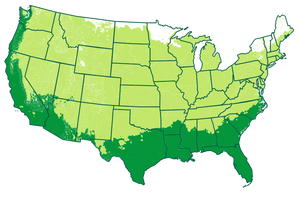* Images shown are of mature plants

Have questions? Talk with our Plant Experts (800) 973-8959
Save 25% on $200+ with code FALL25.
Questions? Call our plant experts: (800) 973-8959
Evergreen Leaves and Certified-Organic Growth
An attractive bush, a renowned leaf for cooking, and a tasty berry—in one plant? You won’t find all three in anything other than the Organic Bay Laurel, a Mediterranean plant that smells as good as it looks.
The Organic Bay Laurel tree, certified USDA organic, is a small-to-medium plant known for its deep green leaves, which are used to add depth of flavor in cooking. The fragrant and evergreen foliage can be dried for later use or used fresh as a seasoning.
Bay Laurels thrive just as well when placed in a container as when planted directly in the ground. What’s more, this fragrant plant can either grow into a small tree or be pruned into a shrub. This easygoing plant can even be trimmed into a topiary or ornamental bush!
The Bay Laurel's aromatic leaves are used in cuisines around the world. Imagine plucking a fragrant leaf from your tree and using it to add seasoning to stews, soups, or braised meats. This Bay Laurel is also organic, meaning that it’s free from pesticides and harmful sprays. Perfect for health-conscious foodies, the tree even produces organic summer berries that attract pollinators, bees, and other friendly wildlife.
With its good looks, aromatic leaves, and tasty berries, the Organic Bay Laurel does it all. Order yours today!
Planting & Care
1. Planting: When planting your Bay Laurel, find a location that offers full to partial sun (4 to 8 hours of sunlight per day). This tree can adapt to a wide variety of soil type as long as it drains well. When you're ready to plant, dig a hole that's three times the width of the root ball and slightly shallower than the root ball.
Hold the tree straight as you begin to backfill the site tamping down the soil as you go. Back fill the hole, apply water to settle the soil and remove the air pockets.
When selecting a container for your bay laurel, be sure it has plenty of holes in the bottom as drainage is essential. The pot size should be 2 times the size of the one it initially came in.
2. Watering: Stick your finger into the potting soil down to a depth of 2 inches and feel around for any moisture. If the soil is drying out, go ahead and water it until you see it escaping the drainage holes and then stop, or until your ground-planted Bay Laurel's soil is moist. If there is some moisture present, leave it be until the soil dries a bit more.
3. Fertilizing: Considering the Bay Laurel is slow growing, it doesn’t require a great deal of food. However, container plants needs to be fed in spring and maybe again in mid-summer. When fertilizing, a general purpose fertilizer (such as a 10-10-10 formula) is sufficient.
4. Pruning: Bay Laurel should be pruned with a shears in late winter, removing dead and crossing branches and stems, and shaping the tree to the size and form that you desire.
FAQs
What does a laurel tree symbolize?
Where do laurel trees grow?
How big do laurel trees get?
Do Bay Laurels like full sun?
Shipping Details
Estimated Shipping Time: Most orders ship immediately. As noted on the website, some items are seasonal, and may only ship in spring or fall. Once your order is shipped, you'll receive an email with a tracking number.
| Amount of Order | Shipping Charge |
|---|---|
| Less than $49 | $19.95 |
| $49 + | FREE SHIPPING! |
Product Details
| Mature Height: | 10-15 ft. |
| Mature Width: | 8-10 ft. |
| Sunlight: | Full-Partial |
| Growth Rate: | Slow |
| Botanical Name: | Laurus nobilis |
| Does Not Ship To: | AZ,OR |
| Grows Well In Zones: | 4-11 patio / 8-11 outdoors |
| Your Growing Zone: | # |









